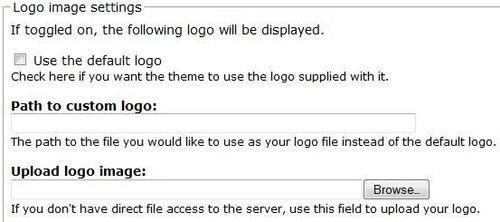Most websites incorporate a logo into their design, usually accompanying the site name in the header. For example, the Drupal logo or "Druplicon" in the following screenshot represents the default logo displayed for every core theme that comes packaged with Drupal:

These logos tend to play an important role in the branding and identity of the site and are frequently an important facet in the overall design of the theme. This recipe details the steps involved in changing the logo displayed in a theme.
The new logo should be in a suitable format and should balance quality with size. The rule of thumb usually followed is as follows:
A custom logo can be added to a theme using the following steps:
1. Navigate to the
admin/appearance[Home | Administration | Appearance] page.2. Click on the Settings link accompanying the theme in question.
3. Look for the Logo image settings fieldset. Within the fieldset, uncheck the Use the default logo checkbox as we want to use a custom image:

The uploaded file is saved in the Drupal filesystem and the path to the logo is registered as a configuration setting in the database. During display, rather than using the logo supplied by Drupal or the theme itself, this setting is loaded to embed the custom logo within the Drupal page. The following screenshot displays the theme with its default logo replaced with a custom PNG:

Besides specifying the logo file via a theme’s configuration page, there are other avenues that can also be pursued.
Alternatively, instead of uploading the logo via Drupal, use the Path to custom logo textfield to point to an existing logo file on the server. This is often handy when the same image is being shared by multiple themes.
Yet another option is to simply place the logo file in the theme’s folder and rename it to logo.png. Provided that the Use the default logo field is checked, the theme will automatically look for this file in its folder and use it as its logo.



